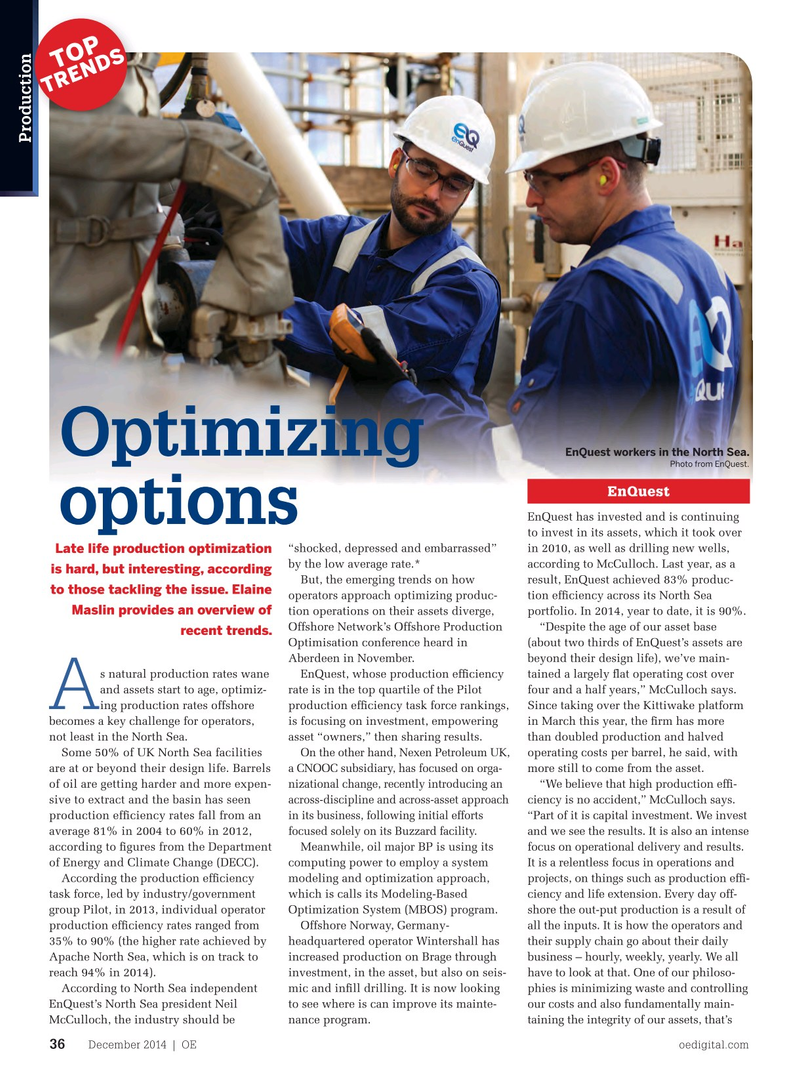
Page 34: of Offshore Engineer Magazine (Dec/Jan 2014)
Read this page in Pdf, Flash or Html5 edition of Dec/Jan 2014 Offshore Engineer Magazine
extremely important to us.”
TOP
EnQuest has seen 84% production
TRENDS growth on the Thistle platform since it took the facility, and a tranche of others including the Heather platform, in 2010,
EyebrowProductionProduction from a Lundin and Petrofac joint venture.
First, production from Thistle, which is 275mi north east of Aberdeen, in 161.5 water depth, was in 1978, with a planned 25-year operating life. Up to the end of 2013, Thistle had produced 10MMbbl.
EnQuest has since added 20MMbbl of reserves to Thistle through drilling and a late life extension project, McCulloch said.
The project, called LLX, saw £170 million spent extending the facilities on
Thistle, shooting new seismic, reactivating the drilling rig and investing in the well stock. The ? rm also invested in making sure electrical submersible pumps got reliable power and brought the platform’s st controls systems “into the 21 century.”
When EnQuest acquired Thistle it was producing about 3000bbl. Enquest increased that to about 18,000 and now
Optimizing
EnQuest workers in the North Sea.
it is at about 10,000, McCulloch says.
Photo from EnQuest. “Ninety percent of that production is from wells we have done something with
EnQuest – whether it is an intervention, a work-
EnQuest has invested and is continuing over or a new well or if we have added options to invest in its assets, which it took over an ESP,” McCulloch says. in 2010, as well as drilling new wells, “shocked, depressed and embarrassed” EnQuest is planning to the same on its
Late life production optimization according to McCulloch. Last year, as a by the low average rate.* Heather, from which it has just com- is hard, but interesting, according result, EnQuest achieved 83% produc- But, the emerging trends on how pleted the ? rst couple of workovers in to those tackling the issue. Elaine tion ef? ciency across its North Sea operators approach optimizing produc- about 10-11 years.
Maslin provides an overview of tion operations on their assets diverge, portfolio. In 2014, year to date, it is 90%.
Offshore Network’s Offshore Production “Despite the age of our asset base recent trends.
Nexen
Optimisation conference heard in (about two thirds of EnQuest’s assets are
Nexen has been using the Choke model,
Aberdeen in November. beyond their design life), we’ve main- s natural production rates wane EnQuest, whose production ef? ciency tained a largely ? at operating cost over set out by BP in SPE paper 36848, to and assets start to age, optimiz- rate is in the top quartile of the Pilot four and a half years,” McCulloch says. capture losses data and move forward to
A ing production rates offshore production ef? ciency task force rankings, Since taking over the Kittiwake platform improve ef? ciency. The choke model looks becomes a key challenge for operators, is focusing on investment, empowering in March this year, the ? rm has more at four main elements – reservoir, wells, not least in the North Sea. asset “owners,” then sharing results. than doubled production and halved plant and export systems, says Dennis
On the other hand, Nexen Petroleum UK,
Some 50% of UK North Sea facilities operating costs per barrel, he said, with
Johnston, production engineer, Nexen.
Part of the problem, Johnston says, is that a CNOOC subsidiary, has focused on orga- are at or beyond their design life. Barrels more still to come from the asset. operators do not always understand nizational change, recently introducing an of oil are getting harder and more expen- “We believe that high production ef? - their ef? ciency rates. How operators across-discipline and across-asset approach sive to extract and the basin has seen ciency is no accident,” McCulloch says. assess what they are doing to reduce in its business, following initial efforts production ef? ciency rates fall from an “Part of it is capital investment. We invest losses is not always clear either, focused solely on its Buzzard facility. average 81% in 2004 to 60% in 2012, and we see the results. It is also an intense with no real system to close loops on according to ? gures from the Department Meanwhile, oil major BP is using its focus on operational delivery and results. losses identi? ed, other than action- of Energy and Climate Change (DECC). computing power to employ a system It is a relentless focus in operations and based systems, with loss entries often
According the production ef? ciency modeling and optimization approach, projects, on things such as production ef? - not reviewed diligently and different task force, led by industry/government which is calls its Modeling-Based ciency and life extension. Every day off- shifts having different views. group Pilot, in 2013, individual operator Optimization System (MBOS) program. shore the out-put production is a result of all the inputs. It is how the operators and Offshore Norway, Germany- production ef? ciency rates ranged from Nexen has been investing in its their supply chain go about their daily headquartered operator Wintershall has 35% to 90% (the higher rate achieved by surveillance and extracting more business – hourly, weekly, yearly. We all increased production on Brage through Apache North Sea, which is on track to data, as well as building digital oil have to look at that. One of our philoso- investment, in the asset, but also on seis- reach 94% in 2014). ? elds to help process the data, to phies is minimizing waste and controlling mic and in? ll drilling. It is now looking According to North Sea independent better understand its losses. Nexen our costs and also fundamentally main- to see where is can improve its mainte- EnQuest’s North Sea president Neil is also performing more process taining the integrity of our assets, that’s nance program. McCulloch, the industry should be trials, to determine capacity where
December 2014 | OE oedigital.com 36 036_OE1214ProdOps.indd 36 11/21/14 9:23 PM

 33
33

 35
35